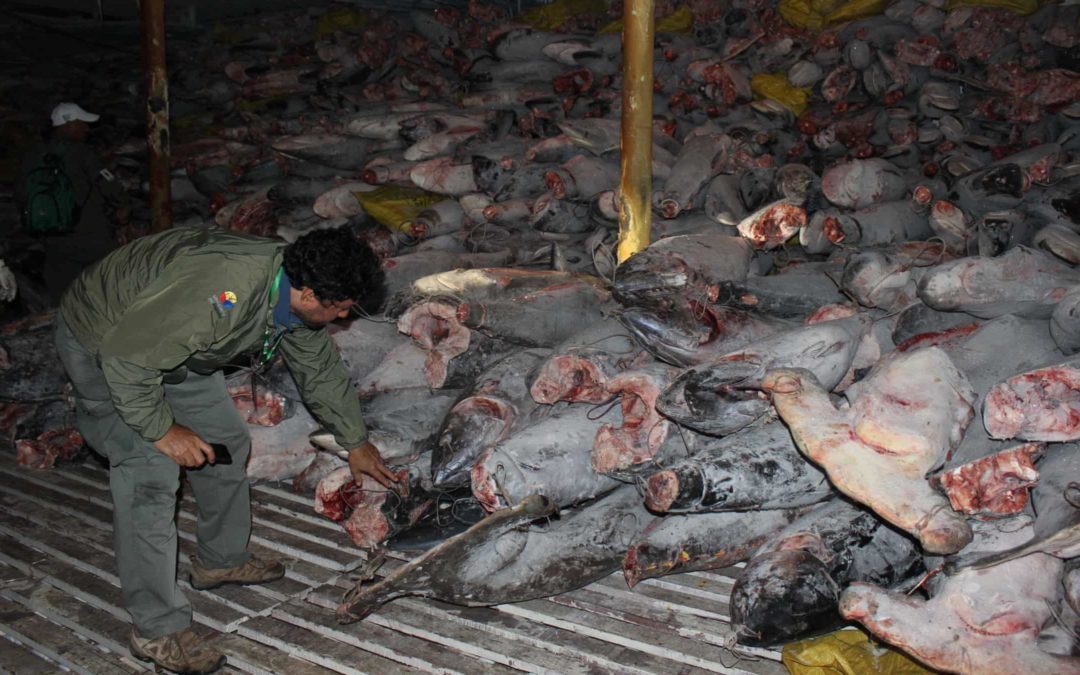SOURCE: The Guardian
DATE: August 6, 2020
SNIP: Jonathan Green had been tracking a whale shark named Hope across the eastern Pacific for 280 days when the satellite transmissions from a GPS tag on her dorsal fin abruptly stopped.
It was not unusual for the GPS signal to go silent, even for weeks at a time, said Green, a scientist who has been studying the world’s largest fish for three decades in the unique marine ecosystem around the Galápagos Islands.
But then he looked at satellite images in the area where Hope was last tracked – more than a thousand nautical miles west of the islands – and noticed the ocean was being patrolled by hundreds of Chinese fishing boats.
“I began to look into it and found that at the very end of her track she began to speed up,” said Green, co-founder and director of the Galápagos Whale Shark Project.
“It went from one knot to six or seven knots for the last 32 minutes – which is, of course, the speed of a fishing boat,” he said.
The fishing vessels that Green saw on the satellite images are believed to belong to an enormous Chinese-flagged fleet which Ecuadorian authorities last week warned was just outside the Galápagos Islands’ territorial waters.
“I don’t have proof but my hypothesis is that she was caught by vessels from the same fleet which is now situated to the south of the islands,” Green told the Guardian. She is the third GPS-tracked whale shark to have gone missing in the last decade, he added.
The Chinese fleet, numbering more than 200 vessels, is in international waters just outside a maritime border around the Galápagos Islands and also Ecuador’s coastal waters, said Norman Wray, the islands’ governor.
Chinese fishing vessels come every year to the seas around the Galápagos, which were declared a Unesco world heritage site in 1978, but this year’s fleet is one of the largest seen in recent years. Of the 248 vessels, 243 are flagged to China including to companies with suspected records of illegal, unreported and unregulated, or IUU, fishing, according to research by C4ADS, a data analysis NGO.
The fleet includes fishing boats and refrigerated container – or reefer – ships to store enormous catches.
Transferring cargo between vessels is prohibited under international maritime law yet the Chinese flotilla has supply and storage ships along with longline and squid fishing boats.
“There are some fleets which don’t seem to abide by any regulations,” said Wray.
One captain of an Ecuadorian tuna boat saw the Chinese fishing boats up close in early July, before the end of the tuna season.
“They just pull up everything!” said the captain, who asked not to be named. “We are obliged to take a biologist aboard who checks our haul; if we catch a shark we have to put it back, but who controls them?”
He recalled navigating through the fleet at night, constantly changing course to avoid boats, as their lights illuminated the sea to attract squid to the surface.
“It was like looking at a city at night,” he said.
The longline fishing boats had up to 500 lines, each with thousands of fishhooks, he estimated, and claimed that some of the vessels would turn off their automatic tracking systems to avoid detection, particularly when operating in protected areas.
Chinese fishing practices first caught the attention of Ecuador in 2017 when its navy seized the Chinese reefer Fu Yuan Yu Leng 999 within the Galápagos marine reserve. Inside its containers were 6,000 frozen sharks – including the endangered hammerhead shark and whale shark.
“It was a slaughterhouse,” said Green, describing the images of the cargo hold. “This kind of slaughter is going on on a massive scale in international waters and nobody is witnessing it.”
China’s distant-water fishing fleet is the biggest in the world, with nearly 17,000 vessels – 1,000 of which use “flags of convenience” and are registered in other countries, according to research by the Overseas Development Institute.
The fleet often fishes in the territorial waters of low-income countries, the report said, having depleted fish stocks in domestic waters.
Green said the “explosion of life” created by the confluence of cold and warm ocean currents around the Galápagos Islands is exactly why the Chinese armada is hovering around the archipelago’s waters.
“The Galápagos marine reserve is a place of very great productivity, high biomass but also biodiversity,” he said. The longline fishing technique used by the fleet catch big fish like tuna, but also sharks, rays, turtles and marine mammals like sea lions and dolphins, he added.
“This is not fishing any more, it is simply destroying the resources of our oceans,” Green said. “We should ask whether any nation on this planet has the right to destroy what is common ground.”

